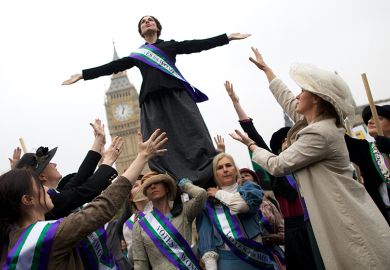A sycophantic early modern etymologist suggested that the name “Elizabeth” derived from the Latin “de insulis”, of the islands: Queen Elizabeth I was coterminous with her land. She was also a queen who was interested in maps: the Ditchley portrait shows her standing on one of England, a Dutch one of 1598 represented her as Europe, and she appears on the frontispieces of atlases. Katja Pilhuj’s smart, lucid book explores the implications of the idea of Elizabeth as world-writer or as surveyor, which is how she was depicted in an image that shows her as, quite literally, the ruler with a ruler.
Perceptively juxtaposing the queen’s image on maps with the ornamental (often semi-clothed) female figures that might alternatively appear on them, Pilhuj traces the impact of the ubiquitous woman-as-land trope both as it affected Elizabeth and as it subsequently figured in a variety of early modern texts.
The book focuses mainly on plays, as suggested by the title, but it also considers Elizabeth Cary’s The History of the Life, Reign and Death of Edward II (although Cary is famous mainly for a play, The Tragedy of Mariam, this is a prose history). The attention to Cary means that the book offers something still rare in discussions of early modern drama, a gender balance: there are two chapters on female writers (Cary and Margaret Cavendish) and two on male (Marlowe and Thomas Heywood). The symmetry is not quite perfect, though, because there is also a conclusion that takes us into the reign of Queen Anne and briefly considers plays by Aphra Behn, Mary Pyx and Mary Davis.
Both the near-equal treatment of male and female authors and the fact that it is actually not quite equal testify to a principal characteristic of this book: it is in constant danger of becoming schematic, but in fact it avoids that trap. To borrow a term more usually applied to creative work, it is very high-concept, and I did once or twice think it was about to succumb to the cult of the grand statement, as when we hear about “The changing symbolic import of female bodies that complements the dissemination of maps as commodities”. Can that really be true, and even if it were could anyone demonstrate it? Actually, though, she does pull it off, and delivers a sustained and consistently interesting analysis of how discourses of mapping affected discourses of gender. She is also good at observing other things that geography might influence, such as genealogy and pedigrees, and there are some fascinating sidelights such as the depiction on maps of the hypothetical continent of Magellanica.
The book’s main strength, though, and the reason it persuades rather than asserts, is its careful attention to detail, often in the shape of good close reading. The discussion of Marlowe’s Tamburlaine plays, for instance, focuses on the often-neglected figure of Zenocrate, and accounts in a novel and satisfactory way why it is she who puts the crown on Tamburlaine’s head. The discussion of Heywood offers a lively reading of his Fair Maid of the West, Bess Bridges. The book is also generously illustrated, albeit in black and white, and overall offers a strong analysis of a suggestive topic.
Lisa Hopkins is professor of English at Sheffield Hallam University.
Women and Geography on the Early Modern English Stage
By Katja Pilhuj
Amsterdam University Press, 280pp, £89.00
ISBN 9789463722018
Published 21 October 2019
Register to continue
Why register?
- Registration is free and only takes a moment
- Once registered, you can read 3 articles a month
- Sign up for our newsletter
Subscribe
Or subscribe for unlimited access to:
- Unlimited access to news, views, insights & reviews
- Digital editions
- Digital access to THE’s university and college rankings analysis
Already registered or a current subscriber?








